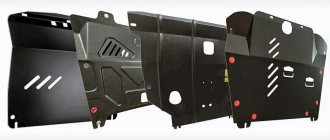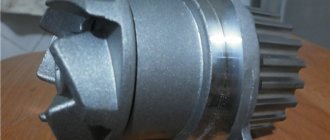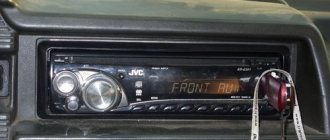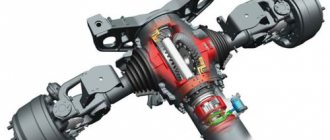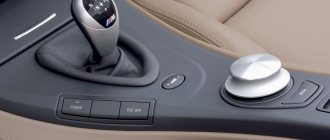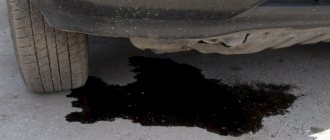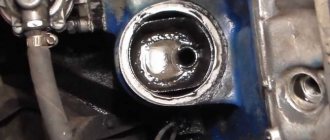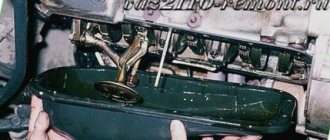Welcome, friends, to the DIY auto repair website. Crankcase protection is an invariable attribute of modern cars. Many manufacturers install protection at the factory.
Engine crankcase protection
But more often than not, the new owner himself makes the decision whether to install such “armor” on his car or not. At the same time, the variety of materials, shapes and designs is often confusing.
A person does not know how to choose crankcase protection and what parameters to pay special attention to. In this article we will look at the main points that will allow you to clearly and accurately determine the appropriate design.
Basic requirements for crankcase protection
There is no state standard for crankcase protection, because they do not apply to automobile units, the certification of which is mandatory under Russian rules. This explains the wide range of protection parameters offered on the market. The main requirement for protection is set by common sense: their main quality is strength and rigidity, which determine the ability to withstand impact loads.
When hitting an obstacle, part of the impact energy is absorbed by the protection itself and its fastening, and part is transferred to the body. In this case, the body and its elements should not be deformed. It is these conditions that the mechanical properties of such equipment must meet.
The rigidity of the protection can be considered optimal if deformation occurs only within the gap between it and the crankcase (usually this gap is selected within 20–30 mm, since its further increase leads to a decrease in ground clearance). This is due to the fact that:
- can lead to damage to the body, since all the impact energy will be transferred to it;
- protection with insufficient rigidity is sometimes capable of converting a frontal impact into a sliding one, but it can rest against the crankcase and damage it.
In addition, rigidity is determined by safety conditions - in the event of a frontal collision, the engine should move downwards and not towards the driver and front passenger. To prevent the protection from interfering with this, it is made with a downward deflection. This ensures its directional deformation when the front part of the car is crushed.
The strength of the protection is ensured by the design and materials used. It must be such that it can withstand a collision with a sharp stone, metal rod, etc. without serious damage.
The stronger and more rigid the protection, the more stiffening ribs it has and the greater their depth. The best model is with deep relief over the entire area, which gives it high rigidity in both longitudinal and transverse sections.
The strength of the fastening is guaranteed by installing protection only on the power elements of the car - body side members, engine subframe, suspension cross member. Attaching the protection to weaker elements, such as the cross member under the radiator, is not strong enough; this is only permissible for anthers. If the protection is installed in this way, the radiator may suffer from an impact.
The strength of the fastening is also ensured by the use of appropriate fasteners - the strength and rigidity of the legs and protection brackets, and the material from which the bolts are made, become decisive.
The weight of the protection should be as low as possible while ensuring the necessary rigidity and strength. Therefore, its value for products offered by manufacturers is in the range of 7–15 kg, which does not lead to a noticeable increase in the load on the front axle of the car.
To determine the degree of rigidity of the protection at home, it is recommended to place it on the ground with the convex side up and stand on it. Good protection under a weight of 75 kg will bend no more than 10-15 mm without permanent deformation. If the deflection is greater, it is most likely a boot.
In addition to the above, good protections are characterized by the fact that they are installed on standard fasteners and there is no need to make additional holes in the body.
They must also have technological openings that make it easier to service a vehicle with installed protection, because eliminate the need for systematic dismantling when it is necessary to drain the oil, clean the filter, etc.
The quality of manufacturing of this equipment is also very important - the quality of painting, which, as a rule, serves as protection against corrosion, and trimming of edges, which affects not only the aesthetic perception of the product, but also the quality of its installation.
Another important attribute of good protection is the presence of rubber or plastic bumpers-shock absorbers at the points of contact with the car body, thanks to which the installed product does not vibrate, which means it does not create and even reduces the noise level in the cabin.
Description
Since doubts about the need to install the element have disappeared, let’s look at what the engine crankcase protection looks like. Visually, a part is a piece of material that has a shape, size and profile. The product is attached to the bottom of the car and tightly covers the elements and parts that need protection.
Protection must be installed on all types of transport, since the part allows you to avoid most possible risk scenarios. A category of vehicles whose intended use is inconceivable without the use of protection. These are cars that travel over rough terrain, SUVs. Such vehicles include: Toyota Land Cruiser 200, Nissan X-Trail, Land Rover Sport. Cars with low ground clearance are primarily equipped with protection, since they have a high risk of getting into an unpleasant situation.
There is no single standard regulated by legal or international agreements for protection. For this reason, most manufacturers neglect the reliability and functionality of the product, equipping the transport with a plate suitable for use as a decorative element.
To perform the assigned function, the product meets the requirements:
- Strength and rigidity of protection: the use of design techniques in the form of profiling and stiffening ribs, the material and thickness of the sheet are also important;
- The use of technological holes and slots for access to components and elements in the space under the hood of a car;
- The protection does not interfere with the cooling and heat transfer of the power unit;
- The fixation of the product is strong, reliable, and does not violate the geometry and structure of other parts;
- The protection is mounted at a distance from the oil pan and at the same time does not reduce the vehicle's ground clearance.
The selection and installation of protection is approached responsibly, since for each vehicle its design, operational and other requirements are taken into account. For example, the engine crankcase protection on a Mitsubishi ACX car takes into account the year of manufacture and provides a recess for the boot. In addition, the material of the product plays a role.
Why is crankcase protection necessary?
The main purpose of such crankcase protection is to prevent damage to the engine when colliding with stones, stumps on the road and various small obstacles. High-quality protection will absorb the main force of the impact, protecting the engine from various types of serious damage.
If previously steel protections were predominantly used, which were made of strong and durable metal, today you can increasingly see new cars in which such an element is made of plastic. It would seem that plastic is not a very reliable and durable material, especially in comparison with durable thick steel.
However, today many automakers use various composite polymers, which in their performance characteristics are practically not inferior to metal. One of the advantages of such composite polymers is their strength properties and elasticity, so even with significant impacts, such protection does not receive dents, which significantly extends the service life of such products.
Damage to expensive parts in an accident
The crankcase protection is a special plate that is installed on the bottom of the car under the engine. It can be made of either plastic or metal. Its main function is to protect the engine from external mechanical influence, for example, from hitting a large stone on the road.
Today on the market there are products in this category with ill-conceived designs. The installation of such parts may adversely affect the condition of the vehicle in the event of a traffic accident. The damage to a car involved in an accident will increase due to the fact that the protection will damage the internal expensive parts of the car.
The same situation can arise if the pallet was not secured correctly. As a result of an accident, it can separate and cause additional damage to the car.
Engine crankcase protection: plastic, iron and other options
Before you start choosing engine protection, you need to understand what this element is. Structurally, engine protection is simply a piece of metal with fasteners cut into it, installed under the bottom of the car in the area of its crankcase. The protective element is most often made from the following materials:
- – steel;
- – aluminum;
- – carbon fiber.
Some car owners, due to lack of sufficient experience, fear that the protection may lead to engine overheating. This is fundamentally wrong: this device has no effect on cooling and even helps to improve it. The fact is that the protective element covers the engine sump from dirt, which sticks in a thick layer and interferes with normal heat transfer.
Let's figure out which engine protection is better - plastic or iron.
Main selection criteria
The main requirement for protection is rigidity. If the protective pallet is made of flexible material, then even a moderate impact can have catastrophic consequences. The impact through such protection will go into the crankcase, causing its damage. Such protection is simply meaningless.
If you decide to install a metal protective tray, make sure that its thickness is at least 3 millimeters. Otherwise, the sheet will simply not be able to withstand possible impacts.
A very important factor is the weight of the protection. It must be remembered that when designing a designer, they clearly calculate the weight distribution of the body. This means that any load on the suspension can upset the proportions specified by the manufacturer.
SUV with protection
You should not lose attention to such an important factor as safety during a traffic accident. The protective pan should not affect the body deformation model envisaged by the designers.
Another important point worth paying attention to is noiselessness. As a rule, noise occurs when the pan comes into contact with the subframe and all this can be heard very well in the cabin when driving.
When choosing protection for your car, be sure to follow these recommendations and be sure to take into account 4 main parameters:
- high rigidity;
- as little weight as possible;
- safety during a collision;
- silent while driving.
Composite materials
Nowadays, protective trays made of composite materials are very popular, especially on imported cars. The most common is fiberglass. What is he like? In short, it is a composite material made using a special technology, which includes special reinforcing glass threads.
Fiberglass tray
Typically, the protection consists of six layers of reinforcing material, which are bonded together with a special resin.
pros
- The engine sump, made of composite materials, is quite durable. Some samples of carbon fiber are used in the construction of spaceships and Formula 1 cars.
- A big advantage when compared with metal protection is that during a collision this protection bursts. This allows the engine to go in the right direction. Carbon fiber can last longer because it does not corrode.
- During production, it is possible to create pallets of any shape that fully correspond to the geometry of the engine with all the necessary technological holes provided.
- The composite protection springs during impacts and this protects it from deformation.
- Very light weight, the usual weight of standard protection is up to four kilograms.
- Very resistant to aggressive environments.
- Silent.
- Does not reduce ground clearance.
Kevlar tray
Minuses
- Among the negative aspects, it is worth noting the much higher cost than metal, as well as more complex repairs;
- Defective products are very common;
- If the production process has not been fully followed, the composite may, under certain conditions, release harmful substances.
Is it possible to make and install engine crankcase protection with your own hands?
Indeed, you can do the protection of the internal combustion engine yourself, but be prepared for the fact that this process is not at all simple. First you need to find out about the required sizes. You can take measurements yourself or by referring to specialized literature or forums discussing the model of your car.
Please note that the sheets should not be placed close to the motor. When developing them, it is necessary to take into account the design of the internal combustion engine. After this, select the material from which you will make the product. Stainless steel models are the most popular. The final stage is installation. Of course, a do-it-yourself option will be more cost-effective than a ready-made one. But there is no guarantee that your actions will be correct. That is why we recommend using ready-made types of engine crankcase protection.
Self-production
To make a pallet with your own hands, you will need wrenches, a tape measure, an angle grinder, a drill, a welding machine and steel. Factory protection is made by stamping. It is provided with stiffening ribs, which cannot be produced without a press. When choosing steel for self-production, it is recommended to take into account the thickness of the sheet (at least 4 millimeters).
It will also be interesting to read: Car battery chargers: the best options on the market
If during manufacturing it is necessary to bend the material, then the sheet is clamped between special corners in clamps. For bending, a fork lever or a gas cutter is used. Auto mechanics advise covering the entire engine with a shield. In this case, additional protection of the crankcase and engine compartment from snow, water and dirt is provided.
To determine the size of the shield, the car is installed on an overpass or lift. The bottom where the steel sheet will be mounted is measured. The obtained data is transferred to the metal. When applying markings, you need to take into account the space for turning wheels, moving various suspension mechanisms and other drives. The minimum value of the indicator is 10 mm.
Mounting options
Before cutting the metal, a method of attaching the protection for the car engine is thought out: on the frame, body or other part. It is recommended to use a threaded connection. The following fasteners are used on the protection:
- Making eyelets as a continuation of the sheet. After marking them, holes of the appropriate diameter are made.
- Separate production of brackets of various shapes: corners, brackets, plates. To fix them to the bottom, a threaded connection is used, and welding to the protection. To give the structure greater rigidity, it is recommended to overlap the parts.
The prepared part with brackets is mounted on bolts. Before installation, it is recommended to check the clearances with the moving elements and the pallet, as well as the alignment of the holes for fasteners.
Installation work
During installation, it is recommended to make an additional hole under the oil drain hatch to provide access to the appropriate filter. Taking into account the size, the hole is cut with a grinder or a crown.
Please note that open access allows dirt to enter the engine compartment. To prevent such a problem, 4 holes are drilled on top of the sheet around the perimeter of the hatch. Nuts are welded to them, into which bolts are then screwed to secure the cover. To provide additional protection and extend service life, the product is primed and painted. When making your own protection, you must comply with the following requirements:
It will also be interesting to read: Car batteries: how to choose the right option
The high strength of the product is ensured by the presence of longitudinal ribs and the use of a special profile or thick steel sheet during the production process. Providing technological holes to provide access to the crankcase drain plug during engine inspection. The protection is installed in such a way as not to disrupt the heat transfer and air flow of the power unit
Particular attention is paid to the natural cooling process. The use of reliable fasteners to ensure a strong connection between the sheet and the frame. The profile provides an air gap within three centimeters from the pallet. At the same time, it is recommended to monitor the clearance value
The indicator should not be small. The presence of many holes in the protective sheet negatively affects the strength, so their number should be minimal.
Best crankcase protection: steel, aluminum or carbon?
Protection made from structural steel , a relatively cheap material with a thickness of 2–3 mm, is most widespread. The plasticity of steel makes it possible to create stiffening ribs on the product by stamping (photo 4). Such protections can be easily adjusted in case of deformation from an impact.
Sheet steel makes it possible to manufacture protection with stiffeners
Most domestic manufacturers of steel protection coat their products with hot-curing epoxy polyester powder paint. This coating is quite durable with careful driving.
Inexpensive products for domestic cars are painted with ordinary nitro enamel. But even the best-quality coating cannot withstand mechanical impact, for example, when hitting a curb while parking.
Aluminum guards are lighter than steel ones, but are about five times more expensive. Therefore, they are especially often installed on sports cars, where weight plays a decisive role. For the manufacture of protection, both soft aluminum alloys and heat-strengthened (duralumin) D16T or B95 are used. In terms of strength, duralumin is not inferior to steel, but low ductility does not allow stamping of stiffeners. The design of such protections most often consists of a flat sheet 7–10 mm thick with several small transverse bends and holes for fastening and ventilation (photo 5).
Protection made of heat-strengthened aluminum alloy without longitudinal stiffeners
Heat-strengthened protections are much more difficult to straighten after an impact.
Composite protections (photo 6) are made from composite materials consisting of a base - reinforcing fiber and a binder - resin. Fiberglass is most often used as a base, less often carbon fiber, which is more expensive and less technologically advanced. The most durable material for composite protection is Kevlar fabric, developed for body armor, but its high price limits its use.
Composite protection
In terms of specific strength, glass and carbon fiber are 1.5 times superior to steel, and Kevlar is 2.5 times superior, which makes protection easier. However, composites do not withstand concentrated loads well. When hitting a sharp object, the resin crumbles, and the fibers that have lost their support break. Therefore, the thickness of composite protections has to be increased to 8–12 mm, which reduces their weight advantage.
Composite protections simultaneously serve as a boot, as they completely cover the engine compartment from below. Manufacturing technology allows them to be given any shape, but they are more expensive than steel ones.
The high strength of the fibers, increased thickness and trough-shaped shape make them very rigid. If the composite protection has cracks, it cannot be restored.
Self-production
To make a pallet with your own hands, you will need wrenches, a tape measure, an angle grinder, a drill, a welding machine and steel. Factory protection is made by stamping. It is provided with stiffening ribs, which cannot be produced without a press. When choosing steel for self-production, it is recommended to take into account the thickness of the sheet (at least 4 millimeters).
If during manufacturing it is necessary to bend the material, then the sheet is clamped between special corners in clamps. For bending, a fork lever or a gas cutter is used. Auto mechanics advise covering the entire engine with a shield. In this case, additional protection of the crankcase and engine compartment from snow, water and dirt is provided.
To determine the size of the shield, the car is installed on an overpass or lift. The bottom where the steel sheet will be mounted is measured. The obtained data is transferred to the metal. When applying markings, you need to take into account the space for turning wheels, moving various suspension mechanisms and other drives. The minimum value of the indicator is 10 mm.
Mounting options
Before cutting the metal, a method of attaching the protection for the car engine is thought out: on the frame, body or other part. It is recommended to use a threaded connection. The following fasteners are used on the protection:
- Making eyelets as a continuation of the sheet. After marking them, holes of the appropriate diameter are made.
- Separate production of brackets of various shapes: corners, brackets, plates. To fix them to the bottom, a threaded connection is used, and welding to the protection. To give the structure greater rigidity, it is recommended to overlap the parts.
The prepared part with brackets is mounted on bolts. Before installation, it is recommended to check the clearances with the moving elements and the pallet, as well as the alignment of the holes for fasteners.
Installation work
During installation, it is recommended to make an additional hole under the oil drain hatch to provide access to the appropriate filter. Taking into account the size, the hole is cut with a grinder or a crown.
Please note that open access allows dirt to enter the engine compartment. To prevent such a problem, 4 holes are drilled on top of the sheet around the perimeter of the hatch. Nuts are welded to them, into which bolts are then screwed to secure the cover. To provide additional protection and extend service life, the product is primed and painted. When making your own protection, you must comply with the following requirements:
The high strength of the product is ensured by the presence of longitudinal ribs and the use of a special profile or thick steel sheet during the production process. Providing technological holes to provide access to the crankcase drain plug during engine inspection. The protection is installed in such a way as not to disrupt the heat transfer and air flow of the power unit
Particular attention is paid to the natural cooling process. The use of reliable fasteners to ensure a strong connection between the sheet and the frame. The profile provides an air gap within three centimeters from the pallet. At the same time, it is recommended to monitor the clearance value
The indicator should not be small. The presence of many holes in the protective sheet negatively affects the strength, so their number should be minimal.
How to choose crankcase protection
Installing a good crankcase protection will protect the units from damage on our roads, but can it also cause harm? Let's try to understand this issue. Should I install crankcase protection or not? And if so, which one is preferable?
Most manufacturers equip their cars only with plastic engine crankcase protection. In fact, it protects only from dirt, and not from mechanical impact. Some auto giants still install some kind of metal protection, but there are also those who do not install anything at all.
Risk factor
The market for non-original additional equipment comes to the aid of owners who need complete protection of their units. It happens that for one car model there are as many as six different protection options available. The other side of the coin is that this equipment is not certified by the automakers themselves. At the official level, they say that the installation of such protections can affect the passive safety of the car in collisions and the temperature conditions under the hood. In the first case, human lives are at risk, and in the second, there is a risk of overheating and engine or gearbox failure. In this case, everything will depend on the specific car model, that is, its design features. For some, additional protection can play a significant negative role, for others - not.
In fact, the automakers are absolutely right, but the whole situation is governed by the word “may.” No one has conducted crash tests of cars with additional protection or any full-fledged studies on their effect on the operation of engines or gearboxes. In practice, there are no statistics that could confirm the negative impact of such additional equipment.
In theory, additional protection certainly affects the distribution and absorption of impact energy throughout the power structure of the car and can lead to the fact that the engine will not be able to go under the car. However, no practical confirmation of this can be found in any body shop. There is also no consistent relationship that additional protection aggravates the consequences of an accident.
Non-standard engine crankcase protection, of course, affects the temperature regime under the hood, or more precisely, the aerodynamic air flows. Theoretically, its installation can worsen the cooling of the engine and gearbox. After all, its shape and location of the ventilation holes (if any) differ from the factory boot. However, in reality, there is no statistical evidence of possible harm on this issue. Failures of units due to overheating are mainly associated with their design flaws or malfunctions of the cooling system itself.
The practice of official dealers, who themselves offer the installation of non-original protections, sometimes even several types, also plays against the position of automakers. It is difficult to imagine that in this situation the client would be denied warranty repair of units, the malfunction of which could theoretically be affected by the introduction of such additional equipment. Therefore, if you are afraid of possible problems, but you still need protection, but are running out of money, then buy and install on the side one of its types, which is offered by the dealer. In the event of a warranty claim, no one will look at where it was installed for you. Remember, the mere fact of having non-original protection is not a reason to refuse warranty repairs, for example, due to engine overheating. A cause-and-effect relationship still needs to be established.
On some car models, the standard boot is a solid sheet of plastic with scanty ventilation holes or no ventilation holes at all. In this case, installing metal or composite protection will not change the climate under the hood at all.
Dressing room
The market offers three types of crankcase guards: steel, aluminum and composite. At the same time, variations in shape and thickness are also possible for the same car.
The most budget-friendly are steel options. Unfortunately, they are heavy and provide the least protection. The degree of deformation is the most significant of the trio.
In approximately the same price range, which is almost twice the steel level, are aluminum and composite options. The latter type has the lowest weight with similar strength characteristics to the aluminum version. Unfortunately, under certain impacts, the composite material cracks and breaks down, and the protection will have to be thrown away. But the aluminum analogue can still be straightened and installed again.
Mounting options for different types of protection may differ significantly. Some can be removed and installed when changing the oil in a couple of minutes, while others will require much more time. All other things being equal, it is better to choose the option that will have the simplest and most reliable fasteners. This is where the experience of other owners will come to the rescue. Otherwise, you will have to constantly resort to intricate techniques when removing and installing, so as not to break soured fasteners, which can be extremely poorly positioned. Sometimes there are protections with technological windows under the drain plugs and the oil filter, but more often than not it is easier to dismantle such protection, so as not to have to wipe off the oil that has spread over it for a long time and persistently.
Author: Stanislav Panin
Did you like the post? Like and share it with your friends on social networks!
Source
Crash test
In theory, additional protection certainly affects the distribution and absorption of impact energy throughout the power structure of the car and can lead to the fact that the engine will not be able to go under the car. However, no practical confirmation of this can be found in any body shop. There is also no consistent relationship that additional protection aggravates the consequences of an accident.
Non-standard engine crankcase protection, of course, affects the temperature regime under the hood, or more precisely, the aerodynamic air flows. Theoretically, its installation can worsen the cooling of the engine and gearbox. After all, its shape and location of the ventilation holes (if any) differ from the factory boot. However, in reality, there is no statistical evidence of possible harm on this issue. Failures of units due to overheating are mainly associated with their design flaws or malfunctions of the cooling system itself.
Steel crankcase protection
Steel crankcase protection is the most popular product that has the most attractive price.
Steel crankcase protection is the most popular product that has the most attractive price.
The most budget-friendly are steel options. Unfortunately, they are heavy and provide the least protection. The degree of deformation is the most significant of the trio.
Steel
Steel is the most common material used in the production of oil pans for quite a long time.
pros
The main advantages of steel protection are:
- fairly simple recovery after a strong blow - straightening;
- high rigidity;
- low price.
Steel pallet
Minuses
- However, in addition to the undoubted advantages, there are also several disadvantages, the main one of which is corrosion.
- Poorly made pallets can resonate strongly while driving, creating unpleasant sounds.
- Sometimes the protection touches the crankcase of the power unit, and this can cause holes to appear through which oil begins to flow.
- The weight of the protective sheet is very large, sometimes it can reach up to fifteen kilograms.
- Significantly reduces ground clearance, as a result of which the car, on rough terrain, can, as drivers say, “lie to the bottom.”
- Incorrectly made or incorrectly installed steel protection very often prevents the motor from running away, thereby creating a danger during a collision.
Loading …
Criterias of choice
- Rigidity is an indicator of the reliability of crankcase protection. The structure is installed to protect the elements of the lower part of the car from impact. If the material bends with a slight push, the protection loses its meaning. The fragile engine oil sump will suffer, and you will have to spend money on repairs. Pay attention to the thickness of the metal.
- Weight of crankcase protection. The manufacturer specified the permissible load on the suspension. An imbalance is a shift in body weight distribution parameters.
- Safety in case of road accidents. The armor should not affect the body deformation scheme laid down by the manufacturer.
- Quietness is a criterion related to the comfort of passengers and the driver. After installation, the crankcase protection knocks on the subframe, which can be heard inside the car. Depends on correct installation.
Crankcase protection is a necessary design for a car in Russian road conditions that are far from ideal. The armor will protect the underbody parts of the car from damage, saving time and money for the car owner.
Owner reviews
If you have not yet decided which protection is better, perhaps reviews from car owners will help you make the right choice.
Composite protection
| Positive reviews | Negative reviews |
| Very light | High price |
| Easy to install | The holes were slightly shifted |
| Withstands hitting rocks |
Steel protection
| Positive reviews | Negative reviews |
| Low price | Started to rust |
| Takes hits well | Noise appeared after installation |
| Quick installation | Very heavy |
Aluminum crankcase guard
Aluminum crankcase protection costs a lot of money. But it is durable, lightweight and can be restored.
Aluminum crankcase protection costs a lot of money. But it is durable, lightweight and can be restored.
Mounting options for different types of protection may differ significantly. Some can be removed and installed when changing the oil in a couple of minutes, while others will require much more time. All other things being equal, it is better to choose the option that will have the simplest and most reliable fasteners. This is where the experience of other owners will come to the rescue. Otherwise, you will have to constantly resort to intricate techniques when removing and installing, so as not to break soured fasteners, which can be extremely poorly positioned. Sometimes there are protections with technological windows under the drain plugs and the oil filter, but more often than not it is easier to dismantle such protection, so as not to have to wipe off the oil that has spread over it for a long time and persistently.
Photo: the author and “Behind the wheel”
